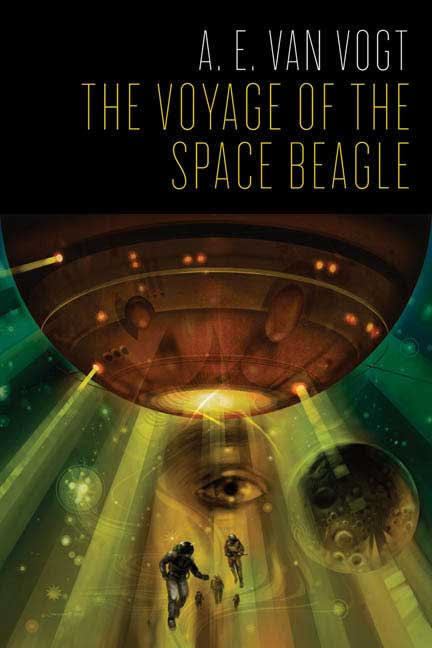7.6 /10 1 Votes7.6
Country United States Publication date 1950 LC Class 50-14253 OCLC 1240657 | 3.8/5 Goodreads Language English Pages 240 pp Originally published 1950 Publisher Simon & Schuster | |||||||||||||||||||||||||||||||||
 | ||||||||||||||||||||||||||||||||||
Genres Novel, Science Fiction, Speculative fiction Similar A E van Vogt books, Science Fiction books | ||||||||||||||||||||||||||||||||||
The Voyage of the Space Beagle (1950) is a science fiction novel by A. E. van Vogt in the space opera subgenre. The novel is a "fix-up" compilation of four previously published SF stories:
Contents
The book was republished in 1952 under the title Mission: Interplanetary.
A huge globular spaceship, manned by a chemically castrated all-male crew of nearly a thousand, who are on an extended scientific mission to explore intergalactic space, encounters several, mostly hostile, aliens and alien civilizations. On board the spaceship during its journey, both political and scientific revolutions take place.
The title of the book is a reference to The Voyage of the Beagle, Charles Darwin's book about his five-year voyage around the world on the HMS Beagle.
Plot summary
The main protagonist of the novel is Dr. Elliott Grosvenor, the only Nexialist on board (a new discipline depicted as taking an actively generalist approach towards science). It is Grosvenor's training and application of Nexialism rather than the more narrow-minded approaches of the individual scientific and military minds of his other shipmates that consistently prove more effective against the hostile encounters both from outside and within the Space Beagle. He is eventually forced to take control of the ship using a combination of hypnotism, psychology, brainwashing, and persuasion, in order to develop an effective strategy for defeating the alien entity Anabis and saving the ship and our galaxy.
The book can be roughly divided into four sections corresponding to the four short stories on which it was based:
In the first section, the Space Beagle lands on a largely deserted desolate planet. Small scattered herds of deer-like creatures are seen, and the ancient ruins of cities litter the landscape. Coeurl, a starving, intelligent and vicious cat-like carnivore with tentacles on its shoulders, approaches the ship, pretending to be an unintelligent animal, and quickly infiltrates it. The creature kills several crewmen before being tricked into leaving the now spaceborne ship in a lifeboat. It then commits suicide when it realizes it has been defeated.
In the second part, the ship is almost destroyed by internal warfare caused by telepathic contact with a race of bird-like aliens, called Riim. The benign signals that the Riim send are incompatible with the human mind. Only Grosvenor's knowledge of telepathic phenomena saves the ship from destruction.
In the third section, the ship comes across Ixtl, a scarlet being floating in deep space. It is a vicious survivor of a race that ruled a previous universe before the Big Bang, the creation of our own universe. Ixtl boards the ship, and being obsessed with its own reproduction, kidnaps several crew members in order to implant parasitic eggs in their stomachs. It is eventually tricked into leaving the ship, after all the crew have left the ship temporarily, leaving no prey left for its offspring to feed on.
In the last section, Anabis, a galaxy-spanning consciousness, is encountered. Once again, it is both malevolent, starving and aggressive, and under all circumstances must be prevented from following the ship back to any other galaxy. Anabis, which is essentially a galaxy-size will-o'-the-wisp, feeds off the death of living organisms, and has destroyed all intelligent life in its galaxy. It transforms all planets it can find into jungle planets through terraforming, since it is these kind of worlds that produce most life. The crew of the Space Beagle lures the intelligence to chase the ship into deep space, causing it to starve to death.
Running concurrently to this, the book also covers a power struggle on the ship among the leaders of individual scientific and military groups.
Reception
P. Schuyler Miller, while praising the original stories, found that the rewriting needed to stitch them into an original novel was inadequate, so that "the whole is less than its original parts."
Recent perspectives
That the novel, first published in 1950, continues to attract readers is indicated by the publication of a reprint edition in 2008. The critic Joe Milicia took the opportunity of this re-issue to revisit the novel in a comprehensive review for the New York Review of Science Fiction. Milicia looks at what today’s reader might find in the novel, noting:
“Thus the stories read as if they were the inspiration for those episodes of Star Trek where some particularly odd and hostile entity must be ingeniously defeated by the Enterprise crew before that entity continues on its marauding path. (Indeed, they very likely were direct inspirations).”Among the surprises identified by Milicia that it may hold for the modern reader are the disharmony aboard the Space Beagle, (“Clearly, Machiavelli rather than Darwin is the true spirit guiding the Space Beagle.”) and that the Space Beagle’s mission is like the original Beagle’s and very unlike the U.S.S. Enterprise’s.
